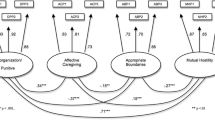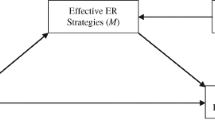Abstract
This study used the Attachment Story Completion Task-Revised (ASCT-R) (Bretherton, Ridgeway, & Cassidy, 1990), a representational measure of attachment security, to examine characteristics of preschool-aged girls' narratives associated with portrayals of attachment to the father. The children's (n = 27) parents had been divorced or legally separated for at least 2 years, and they lived in the primary custody of their mothers. We had previously discovered that girls' responses to the ASCT-R differed from those of boys in unexpected ways. Whereas boys' representations of child-father attachment varied positively with teacher ratings of social behavior in child-care settings, the opposite was the case for girls. Girls who portrayed children's attachment to the father more frequently were rated lower in social competence, contrary to expectations. A more detailed analysis of responses to the ASCT-R suggests that girls' representational attachment behavior toward the father was associated with narrative representations of both parents as unavailable, family instability, and concerns for the father's well-being.
Similar content being viewed by others
References
Ainsworth, M. D. S., Blehar, M. C., Waters, E. & Wall, S. (1978). Patterns of attachment. Hillsdale, NJ: Erlbaum.
Amato, P.R. & Rezac, S.J. (1994). Contact with nonresident parents, interparental conflict, and children's behavior. Journal of Family Issues, 15(2), 191–207.
Behar, L.B. (1977). The preschool behavior questionnaire. Journal of Abnormal Child Psychology 5(3), 265–275.
Behar, L.B. & Stringfield, S. (1974). A behavior rating scale for the preschool child. Developmental Psychology 10(5), 601–610.
Belsky, J. (1999). Interactional and contextual determinants of attachment security. In J. Cassidy & P. Shaver (Eds.), Handbook of attachment: Theory, research, and clinical applications (pp. 249–264). New York: Guilford.
Bowlby, J. (1973). Attachment and loss, Vol. II: Separation: Anxiety and anger. New York: Basic Books.
Bowlby, J. (1982). Attachment and loss, Vol. I: Attachment (2nd ed.). New York: Basic Books.
Bretherton, I., Oppenheim, D., Buchsbaum, H., Emde, R., and the MacArthur Narrative Group (1990). The MacArthur story-stem battery. Unpublished manual, University of Wisconsin-Madison.
Bretherton, I., Page, T., Golby, B., & Walsh, R. (1997). Fathers in Postdivorce Families Seen Through the Eyes of Mothers and Children. Unpublished Report to the Aid Association for Lutherans Scholars' Committee, School of Human Ecology, University of Wisconsin-Madison.
Bretherton, I., Ridgeway, D., & Cassidy, J. (1990). Assessing the internal working models of the attachment relationship: An attachment story completion task for 3-year-olds. In M.T. Greenberg, D. Cicchetti, & E.M. Cummings (Eds.), Attachment in the preschool years: Theory, research, and intervention (pp. 273–308). Chicago: University of Chicago Press.
Byng-Hall, J. (1999). Family couple therapy: Toward greater security. In J. Cassidy & P. Shaver (Eds.), Handbook of attachment: Theory, research, and clinical applications (pp. 625–645). New York: Guilford.
Cassidy, J. (1988). Child-mother attachment and the self in six-year-olds. Child Development, 59, 121–134.
Cassidy, J. & Shaver, P.R. (1999). Handbook of attachment: Theory, research, and clinical applications. New York: Guilford.
Cherlin, A.J.; Furstenberg, F.F.; Chase-Lansdale, P.L.; Kiernan, K.E.; Robins, P.K.; Morrison, D.R.; & Teitler, J.O. (1991). Longitudinal studies of effects of divorce on children in Great Britain and the United States. Science, 252, 1386–1389.
Crittenden, P.M. (1985). Maltreated infants: Vulnerability and resilience. Journal of Child Psychology and Psychiatry, 26, 85–96.
Emery, R.E. (1988). Marriage, divorce, and children's adjustment. Newbury Park: Sage Publications.
Hetherington, E.M., Cox, M. & Cox, R. (1982). Effects of divorce on parents and children. In M.E. Lamb (Ed.), Nontraditional families: Parenting and child development (pp. 233–288). Hillsdale, NJ: Erlbaum.
Hubbs-Tait, L., Hughes, K.P., Culp, A.M., Osofsky, J.D., Hann, D.M., Eberhart-Wright, A., & Ware, L.M. (1996). Children of adolescent mothers: Attachment representation, maternal depression, and later behavior problems. American Journal of Orthopsychiatry, 66(3), 416–426.
Kobak, R. (1999). The emotional dynamics of disruptions in attachment relationships: Implications for theory, research, and clinical intervention. In J. Cassidy & P.R. Shaver (Eds.), Handbook of attachment: Theory, research, and clinical applications (pp. 21–43). New York: Guilford Press.
Lidz, T. (1968). Family organization and personality structure. In N.W. Bell & E.F. Vogel (Eds.), A modern introduction to the family (pp. 575–589). New York: The Free Press.
Main, M., Kaplan, N., & Cassidy, J. (1985). Security in infancy, childhood, and adulthood: A move to the level of representation. In I. Bretherton and E. Waters (Eds.), Growing points of attachment theory and research. Monographs of the Society for Research in Child Development, 50(1–2, Serial No. 209) (pp. 66–104). University of Chicago Press.
Main, M. & Solomon, J. (1990). Procedures for identifying infants as disorganized/disoriented during the Ainsworth strange situation. In M.T. Greenberg, D. Cicchetti, & E.M. Cummings (Eds.), Attachment in the preschool years: Theory, research, and intervention (pp. 121–160). Chicago: University of Chicago Press.
Olson, S.L. (1985). The preschool competence questionnaire: Factor structure, longitudinal stability, and convergence with ratings of maladjustment. Unpublished manuscript, University of Michigan, Ann Arbor, MI.
Olson, S.L. & Lifgren, K. (1988). Concurrent and longitudinal correlates of preschool peer sociometrics: Comparing rating scale and nomination measures. Journal of Applied Developmental Psychology 9, 409–420.
Oppenheim, D., Emde, R.N., & Warren, S. (1997). Children's narrative representations of mothers: Their development and associations with child and mother adaptation. Child Development, 68(1), 127–138.
Page, T. (2001). The social meaning of children's narratives: A review of the attachmentbased narrative story stem technique. Child and Adolescent Social Work Journal, 18, 171–187.
Page, T. & Bretherton, I. (1993). Manual for coding the Expanded Attachment Story Completion Task Adapted for Children of Divorce. Unpublished manuscript, University of Wisconsin-Madison.
Page, T. & Bretherton, I. (2001). Mother-and Father-Child Attachment Themes in the Story Completions of Preschoolers from Postdivorce Families: Do They Predict Relationships with Peers and Teachers? Attachment and Human Development, 3, 1–29.
Shouldice, A.E. & Stevenson-Hinde, J. (1992). Coping with security distress: The separation anxiety test and attachment classification at 4.5 years. Journal of Child Psychology and Psychiatry, 33(2), 331–348.
Shreeve, D.F. (1990). Pseudomaturity in the developmental line of object relations. American Journal of Psychotherapy, 44, 4, 536–551.
Slough, N. & Greenberg, M. (1990). 5 year-olds representations of separation from parents: Responses from the perspective of self and other. In I. Bretherton & M. Watson (Eds.), New directions for child development: Children's perspectives on the family: No. 48 (pp. 67–84). San Francisco: Jossey-Bass.
Solomon, J., George, C., & DeJong, A. (1995). Children classified as controlling at age six: Evidence of disorganized representational strategies and aggression at home and school. Development and Psychopathology, 7, 447–463.
Toth, S.L., Cicchetti, D., MacFie, J., & Emde, R.N. (1997). Representations of self and other in the narratives of neglected, physically abused, and sexually abused preschoolers. Development and Psychopathology, 9, 781–796.
Verschueren, K., Marcoen, A., & Schoefs, V. (1996). The internal working model of the self, attachment and competence in five-year-olds. Child Development 67, 2493–2511.
Wallerstein, J.S. (1984). Children of divorce: The psychological tasks of the child. Annual Progress in Child Psychiatry and Child Development. 263–280.
Wallerstein, J.S. & Blakeslee, S. (1989). Second chances: Men, women, and children a decade after divorce. New York: Ticknor & Fields.
Woolgar, M. J. (1999). Projective doll play methodologies for children. Child Psychology and Psychiatry Review 4(3), 126–134.
Zahn-Waxler, C., Cole, P. M., Richardson, D. T., Friedman, R. J., Michel, M. K., & Belouad, F. (1994). Social problem solving in disruptive preschool children: Reactions to hypothetical situations of conflict and distress. Merrill-Palmer Quarterly 40, 98–119.
Author information
Authors and Affiliations
Rights and permissions
About this article
Cite this article
Page, T., Bretherton, I. Representations of Attachment to Father in the Narratives of Preschool Girls in Post-Divorce Families: Implications for Family Relationships and Social Development. Child and Adolescent Social Work Journal 20, 99–122 (2003). https://doi.org/10.1023/A:1022864614244
Issue Date:
DOI: https://doi.org/10.1023/A:1022864614244




